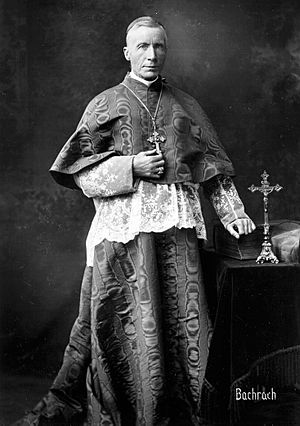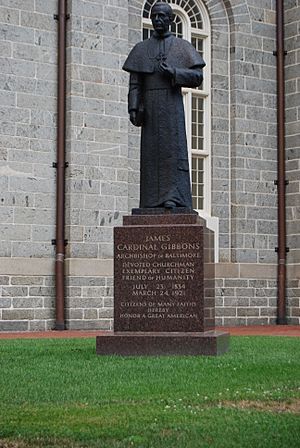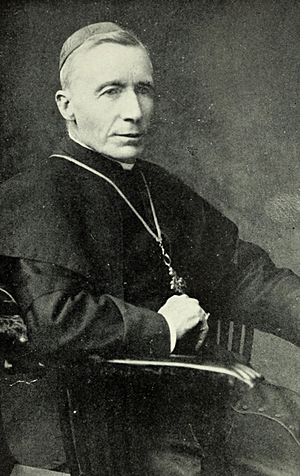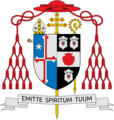James Gibbons facts for kids
Quick facts for kids His Eminence James Gibbons |
|
|---|---|
| Cardinal Archbishop of Baltimore |
|
 |
|
| See | Archdiocese of Baltimore |
| Appointed | May 29, 1877 (coadjutor) |
| Enthroned | October 3, 1877 |
| Reign ended | March 24, 1921 |
| Predecessor | James Roosevelt Bayley |
| Successor | Michael Joseph Curley |
| Other posts | Cardinal-Priest of Santa Maria in Trastevere |
| Orders | |
| Ordination | June 30, 1861 |
| Consecration | August 15, 1868 by Martin John Spalding |
| Created Cardinal | June 7, 1886 |
| Rank | Cardinal- Priest |
| Personal details | |
| Born | July 23, 1834 Baltimore, Maryland |
| Died | March 24, 1921 (aged 86) Baltimore, Maryland |
| Previous post | Bishop of Richmond (1872–77) |
| Motto | Emitte spiritum tuum (Send forth your spirit) |
| Signature | |
James Cardinal Gibbons (born July 23, 1834 – died March 24, 1921) was an important leader in the Catholic Church in America. He served in several key roles. From 1868 to 1872, he was a special church leader for North Carolina. Then, from 1872 to 1877, he was a bishop in Richmond, Virginia.
Later, he became the ninth Archbishop of Baltimore, Maryland, serving from 1877 until his death. In 1886, he was given the high rank of Cardinal. This made him only the second American to become a Cardinal.
Gibbons became a bishop on August 16, 1868, in Baltimore. He was 34 years old at the time. He also attended the First Vatican Council in Rome. There, he supported the idea of papal infallibility, which means the Pope cannot be wrong on matters of faith and morals.
As Archbishop of Baltimore for 44 years, Gibbons was a very well-known Catholic figure. He stood up for the rights of working people and helped convince Pope Leo XIII to support labor unions.
Contents
Early Life and Education
James Gibbons was born in Baltimore, Maryland. He was the fourth of six children. His parents, Thomas and Bridget Gibbons, came from Ireland. The family first moved to Canada, then to the United States.
In 1839, his father, Thomas, got sick. The family moved back to Ireland, hoping the climate would help him. Thomas ran a grocery store in Ballinrobe, where James went to school. After his father died in 1847, James's mother moved the family back to the U.S. in 1853, settling in New Orleans.
James decided to become a priest after hearing a sermon. In 1855, he started studying at St. Charles College, Maryland. After graduating in 1857, he went to St. Mary's Seminary and University in Baltimore. He faced some health challenges during his studies.
Becoming a Priest
On June 30, 1861, James Gibbons became a priest in Baltimore. He first worked at St. Patrick's Parish. Then, he became the first pastor of St. Brigid's Parish. He also took charge of St. Lawrence Parish.
During the American Civil War, Gibbons served as a chaplain for Confederate Army prisoners. In 1865, he became the private secretary to Archbishop Martin John Spalding. Gibbons helped prepare for an important meeting of Catholic leaders in Baltimore in 1866.
His Career as a Bishop
Leading in North Carolina
On March 3, 1868, Pope Pius IX appointed Gibbons as the first special church leader for North Carolina. He became a bishop on August 15, 1868. At 34, he was one of the youngest Catholic bishops in the world. People sometimes called him "the boy bishop."
North Carolina had very few Catholics at the time, fewer than 700. In his first month, Gibbons traveled nearly a thousand miles. He visited towns and small churches, helping people with their faith. He also made friends with many Protestants and preached in their churches.
Gibbons helped many people become Catholic. He also wrote a famous book called Faith of Our Fathers. This book explained the Catholic faith in a simple way. It became very popular among American Catholics.
Gibbons became a well-known religious figure in America. He gave sermons on many topics. He met every U.S. president from Andrew Johnson to Warren G. Harding. He also advised several presidents.
In 1869 and 1870, Gibbons attended the First Vatican Council in Rome. He was one of the youngest bishops there. He supported the idea of papal infallibility. In 1872, he also took on duties for the Diocese of Richmond in Virginia.
Bishop of Richmond
On July 30, 1872, Pope Pius IX named Gibbons the fourth bishop of the Diocese of Richmond. He officially took on this role on October 20, 1872.
Archbishop of Baltimore
On May 29, 1877, Gibbons was named the assistant archbishop of Baltimore. He became the full archbishop on October 3, 1877, after the previous archbishop died. For his first 20 years, he worked without an assistant bishop. He traveled a lot, getting to know the priests and church members very well.
Becoming a Cardinal
On June 7, 1886, Pope Leo XIII made Gibbons a Cardinal. He was the second American to receive this high honor. Gibbons strongly supported creating The Catholic University of America in Washington, D.C. When it opened in 1887, he became its first leader.
In 1899, Pope Leo XIII sent a letter about "Americanism." This letter discussed ideas about individualism and freedom that some thought were too extreme. Gibbons and other American church leaders explained that these ideas were not part of Catholic teachings.
In 1903, Gibbons became the first American cardinal to vote for a new Pope. He also tried to attend the 1914 election for a new Pope, but he arrived too late.
During World War I, Gibbons helped create the National Catholic Welfare Council. He also supported America joining the League of Nations after the war. Initially, he did not support women's right to vote. However, after the 19th Amendment passed in 1920, he encouraged women to vote. He said it was "not only a right but as a strict social duty."
James Gibbons passed away on March 24, 1921, in Baltimore. He was 86 years old.
Supporter of Workers
Cardinal Gibbons was a strong supporter of working people. He believed many Catholics were being treated unfairly as industries grew in American cities. He once said that workers had the right to protect themselves. He also believed everyone should help fix problems like greed and unfair treatment.
Gibbons played a key role in getting the Pope's approval for Catholics to join labor unions. He successfully defended the Knights of Labor, a large union with many Catholic members. This earned him a reputation as a friend of workers. However, he did not support violence during labor disputes.
His Writings
Gibbons was also popular because of the books he wrote. Some of his well-known works include Our Christian Heritage (1889) and The Ambassador of Christ (1896). He also wrote essays for popular magazines. He contributed to the Catholic Encyclopedia. His writing style was simple and easy to understand. Many non-Catholics looked to Gibbons to understand the Catholic viewpoint on important issues.
In 1876, Gibbons published his most famous book, The Faith of Our Fathers. This book explained and defended the Catholic Church. It was highly respected, even by Protestants.

Images for kids
See also
 In Spanish: James Gibbons para niños
In Spanish: James Gibbons para niños
- Catholic Church in the United States
- Historical list of the Catholic bishops of the United States
- James Cardinal Gibbons Medal
- List of Catholic bishops of the United States
- Lists of patriarchs, archbishops, and bishops
- Papal infallibility






